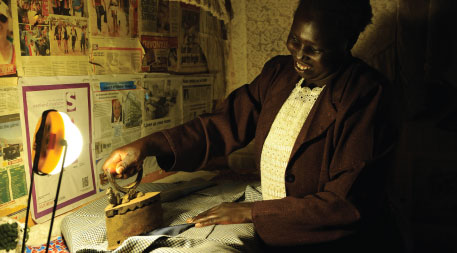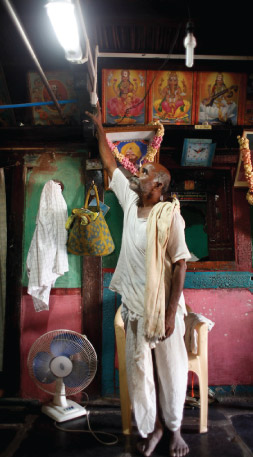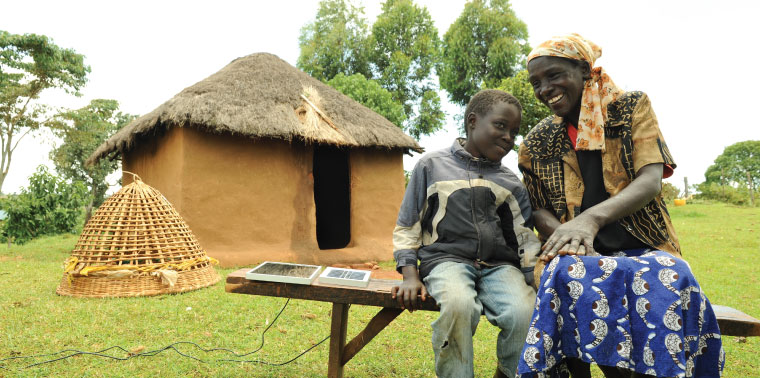February 16, 2013 — The people of Bangalore, India, face eight or more half-hour blackouts each day. Anurag Mehndiratta, a telecommunications engineer there, wanted something more reliable, so he bought a solar water heater and solar photovoltaic system for his home to provide power and comfort when the rest of the city went dark. “Energy is not super expensive in this country, but it’s very unpredictable,” he says. He had lived in the U.S. and upon returning to India, he wanted “at a minimum, seamless power for my home.”
Mehndiratta is one of a billion people around the world who live where electrical grid service is unreliable. At least 1.3 billion more live completely out of range of the grid, and usually these people cannot afford solar setups like the one Mehndiratta had installed. Yet it is easy to see why people would want what solar promises. For starters, it offers an alternative to firewood and kerosene, both of which pollute indoor air. Harvesting firewood can cause deforestation, and kerosene is a leading cause of poisoning and burns in children—and an expensive, poor quality light source to boot. Meanwhile, solar water heaters quickly pay for themselves with the money saved by not having to heat water with electricity, people in remote locations could use solar power to charge cell phones and, well, who doesn’t want a color TV?
“There are 1.3 billion people without electricity as we speak. This figure has remained like this for the last 50 years. If we don’t do anything, it will remain like this until 2030.”
Of course, people forever have used the sun to dry foods, fish, clothes, hides and more, and situated their homes with its rays in mind. Today, low-tech solar options have been installed in the developing world, such as plastic bottles filled with water and bleach stuck through metal roofs to disperse daytime light throughout homes—a simple innovation for capturing sunlight. But higher-tech solutions have struggled to make good on their promise of providing clean, sustainable energy to all.
That might be changing in developing countries, as entrepreneurs test possible solutions to a number of the obstacles solar energy has faced over the years—some technical but many social, economic and political.
Panel Power
One need look no further than mobile phones for a case study of how a small, portable technology brought its services to people far ahead of the advance of large-scale infrastructure. Solar-powered devices are following a similar trend—bringing electricity and its benefits to people well beyond the grid’s reach. The hottest market is for the smallest devices: from little lanterns for illuminating tasks like studying at a desk, making baskets or checking on livestock to tiny “plug and play” systems that can combine, say, a light or two with a cell phone charger using small batteries and book-sized solar panels.

A woman in Kenya irons clothes for the following day’s work using a portable solar lantern. Photo by Andres Bifani/Lighting Africa.
Ned Tozun, president and co-founder of d.light, a company that pioneered this market and claims to have reached 10 million people, sees his products not as an extra expense but as a safer replacement for a dirty alternative on which people already spend plenty of money. “Kerosene is our competition,” he says. According to Sameer Hajee of Cape Town, South Africa–based Nuru Energy (which sells a lamp that can be charged by the sun or by the company’s patented pedal power generator), Africans alone spend $17 billion per year on kerosene for lighting. These and other companies are looking to redirect that expense to safer, cleaner lights.
“Prior to just a couple of years ago, these technologies had not reached anything like [the current] level of scale,” Tozun says. D.light’s lowest-priced product—a puck-shaped device with a solar panel on one side and a light on the other, attached to a wire handle that can be hung from a wall or used as a lampstand—costs about $10. Customers save for the lights as they would for a mobile phone, Tozun says. Keeping it cheap allows the company to sell to consumers without relying on financing the products.
While solar panel fabrication has come down in cost, a key driver of the expansion of these small solar devices has been the development of cheaper, more efficient LED lights. The amount of light delivered per watt has nearly tripled in the last several years, says Arne Jacobson, director of the Schatz Energy Research Center at Humboldt State University in Arcata, Calif. “You have a huge decline in price for the same level of performance.”Beyond small lanterns, larger household photovoltaic systems can power a range of items: more lights, ceiling fans or a television. At an even larger scale, mini-grids—some fueled by solar, but others by biomass or wind—are emerging as new nodes of power to serve areas of 10 or fewer kilometers across that are off the main grid or that have spotty service. And a few locations, such as Burkina Faso and Ghana, are installing large-scale solar systems linked to the grid, says Stephen Gitonga, energy policy advisor to the United Nations Development Programme.
Direct Use
Of course, photovoltaics aren’t the only way to capture the sun’s energy. The sun can be put to direct use as well to replace conventional energy sources that have downsides for human health and the environment.
Solar cooking, for example, reduces smoky indoor fires and the need to gather firewood for cooking, which can contribute to deforestation and put women and children in dangerous situations. However, solar cookers have found only limited use in developing areas.
“Solar cookers are unlikely to be more than a bit player because they require significant changes in cooking habits,” Jacobson says. Users have to cook outside the house and during daylight hours, for example. For these reasons, they may work better for institutions, such as schools or temples, rather than in homes, some experts say.
“Mobile banking and microfinancing—those two things combined are making for some interesting possibilities that weren’t really there just four years ago.”
Still, Patricia McArdle, a long-term member and former board member of Solar Cookers International, thinks more needs to be done to expand the use of solar cooking. “What’s different now is the population is on its way to 9 billion,” she says. “A tree takes 30 years to grow. It takes less than a month to burn in a cooking fire.”
While solar cookers have faced roadblocks, solar water heaters—often arrays of water-filled tubes that heat water directly by soaking up the sun’s rays—are highly efficient and particularly common in cities. Kathmandu, Nepal, for example, has them on nearly every roof, Gitonga notes, while Bangalore, India, has a law requiring that all new construction above a certain size have solar water heating.
“In the case of water heating, it’s just really a straight economic payback where people are using diesel,” says Damian Miller, CEO of Orb Energy, an India-based solar company. Their fast payback has made solar water heaters Orb’s best-selling product.
Overcoming Challenges
The expansion of solar in developing countries has faced challenges at all levels, including governmental, where import tariffs and kerosene subsidies can work against it, and cultural, where technologies sometimes don’t mesh with the way people actually live. Still, many start-up companies, looking to capitalize on an enormous potential market while improving lives, are trying to address these and other challenges—especially distribution, reliability and financing.

A man lights a room with the flip of a switch thanks to a solar system from Orb Energy, a company that designs and installs solar photovoltaic and solar water-heating systems in rural markets throughout India. Photo courtesy of Orb Energy.
One of the key challenges is the “uphill battle of small firms making good products against massive ‘bottom-feeding’ manufacturers dumping shoddy products into the market by the container-load,” says Evan Mills, an energy expert at the Lawrence Berkeley National Laboratory in Berkeley, Calif. D.light’s Tozun agrees: “We go into markets all the time where people … have had a bad experience [with solar]. We are being fanatical about making our products extremely rugged and affordable.”
Lighting Africa and its newer sister organization, Lighting Asia, programs led by the International Finance Corporation, offer product testing and a set of criteria to ensure quality in small devices such as portable lamps. These include making sure a lamp actually delivers the amount of light and battery life claimed on the package and testing whether a product can survive being dropped. They also require a minimum of a six-month warranty. Jacobson, who is the technical lead for the program, says it is beginning to have an effect. Lighting Africa–certified products—40 so far—are gaining market share, with annual sales growing threefold in the past four years.
While reliability is important to encouraging use of any product, so is affordability.
“Mobile banking and microfinancing—those two things combined are making for some interesting possibilities that weren’t really there just four years ago,” Jacobson says. Microfinancing gives small loans to households or businesses, which is a good option for some consumers. But lenders can still be slow and risk averse, and many potential buyers have irregular income streams that make a loan with regular repayment, however small, an intractable option. Paul Needham, founder and president of Simpa Networks, which sells energy technology in India using a “progressive purchase” model, draws an analogy once again to cell phones. While cost declines made it easier for people to afford phones, he says, “the biggest innovation is the prepaid, pay-as-you-go pricing. That allowed companies to serve people who don’t have credit histories.”Simpa Networks and Kenyan solar energy company M-KOPA are bringing pay-as-you-go models to solar photovoltaics while also capitalizing on innovations in mobile banking. In Simpa’s system, customers make payments—via mobile phone if they have access to mobile banking—for a particular amount of energy, and the company unlocks the customers’ equipment until they use what they’ve paid for. When a customer has paid in full for the equipment, it unlocks permanently. Needham believes that this financing approach will allow investment in larger systems by those who would otherwise have been able only to afford a small light.
While many of these ideas are still unproven at the large scale, UNDP’s Gitonga says the sun will play a growing role in providing energy to the developing world. “Solar energy will remain a big piece of energy expansion, especially in decentralized remote areas,” he says. “There are 1.3 billion people without electricity as we speak. This figure has remained like this for the last 50 years. If we don’t do anything, it will remain like this until 2030.”
Ensia shares solutions-focused stories free of charge through our online magazine and partner media. That means audiences around the world have ready access to stories that can — and do — help them shape a better future. If you value our work, please show your support today.
Yes, I'll support Ensia!

For those who'd like to learn more about, and get involved in bringing solar to low-income villagers in developing countries, I compiled relevant resources here:
http://bennu-solar.com/
Hope this helps,
Yotam
(http://www.linkedin.com/in/yotamariel)
WakaWakaLight discovered at a field survey in Northern Nigeria that families did spend 2.5 hours extra every day thanks to their newly acquired solar LED lamp.
Moreover, it is a major step in combatting the forgotten routine horror of heavy poisoning by the suffocating air pollution from toxic kerosene fumes and the 300,000 yearly death victims by burning accidents AND the 6,000,000 severely burned victimes.
This 'silent drama', unfolding e-v-e-ry day, 365 days e-v-e-r-y year has to be stopped.
And it CAN be stopped.
With our solar LED lamp and its 'brother', that also can charge power driven devices like mobile phones, radio's, MP's players and tablets, we hope to contribute to ending this horror, to help escape 'killer kerosene' and to enable also people to build a better future for themselves.
More info: www.wakawakalight.com and www.wakawakafoundation.org
I think that fact alone--having a cell phone but not light--is astonishing. More importantly, it also shows that dispersing solar powered devices with scale is possible in this decade. If cell phones can, then solar lights surely can too.
More info on how people anywhere in the world can invest in rural, off-grid solar projects: www.sunfunder.com
Your article is great. It can complement what we are doing right now. We are into disseminating simple overviews of solar technology for the understanding of the common layperson. Thus simplicity is the theme. Visit us at: http:wwwbuildsolar4betterlife.com